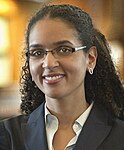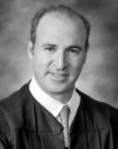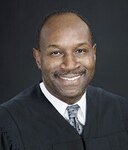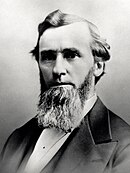|
Supreme Court of California
The Supreme Court of California is the highest and final court of appeals in the courts of the U.S. state of California. It is headquartered in San Francisco at the Earl Warren Building,[1] but it regularly holds sessions in Los Angeles and Sacramento.[2] Its decisions are binding on all other California state courts.[3] Since 1850, the court has issued many influential decisions in a variety of areas including torts, property, civil and constitutional rights, and criminal law. CompositionUnder the original 1849 California Constitution, the Court started with a chief justice and two associate justices.[2][4] The Court was expanded to five justices in 1862.[2] Under the current 1879 constitution, the Court expanded to six associate justices and one chief justice, for the current total of seven.[2][5] The justices are appointed by the Governor of California and are subject to retention elections.[6] According to the California Constitution, to be considered for appointment, as with any California judge, a person must be an attorney admitted to practice in California or have served as a judge of a California court for 10 years immediately preceding the appointment.[7] To fill a vacant position, the Governor must first submit a candidate's name to the Commission on Judicial Nominees Evaluation of the State Bar of California, which prepares and returns a thorough, confidential evaluation of the candidate.[8] Next, the Governor officially nominates the candidate, who must then be evaluated by the Commission on Judicial Appointments, which consists of the Chief Justice of California, the Attorney General of California, and a senior presiding justice of the California Courts of Appeal.[9] The Commission holds a public hearing and if satisfied with the nominee's qualifications, confirms the nomination. The nominee can then immediately fill an existing vacancy, or replace a departing justice at the beginning of the next judicial term. If a nominee is confirmed to fill a vacancy that arose partway through a judicial term, the justice must stand for retention during the next gubernatorial election. Voters then determine whether to retain the justice for the remainder of the judicial term. At the term's conclusion, justices must again undergo a statewide retention election for a full 12-year term.[10] If a majority votes "no", the seat becomes vacant and may be filled by the Governor. The electorate has occasionally exercised the power not to retain justices.[11] Chief Justice Rose Bird and Associate Justices Cruz Reynoso and Joseph Grodin were staunchly opposed to capital punishment and were subsequently removed in the 1986 general election.[12] Newly reelected Governor George Deukmejian was then able to elevate Associate Justice Malcolm M. Lucas to Chief Justice and appoint three new associate justices (one to replace Lucas in his old post and two to replace Reynoso and Grodin).[13] Structure
Between 1879 and 1966, the court was divided by the state constitution into two three-justice panels, Department One and Department Two.[2][14] The chief justice divided cases evenly between the panels and also decided which cases would be heard "in bank" (en banc) by the Court sitting as a whole. During the late 1920s, the court gradually transitioned to routinely hearing all appeals in bank, apart from two unusual exceptions in 1941 when it again tried to sit in departments.[2] The 1966 formal abolition of the department system merely confirmed how the court had been actually operating for quite some time.[2]  Oral argument was mandatory only for in bank hearings of appeals, which meant that many appeals were decided by three-justice departments on the briefs alone.[2] However, the state constitution required department decisions to be unanimous to produce a final judgment.[2] Any dissent automatically triggered an in bank hearing.[2] After a constitutional amendment in 1966, the Court currently sits in bank (all seven together) when hearing all appeals.[2] When there is an open seat on the court, or if a justice recuses himself or herself on a given case, justices from the California Courts of Appeal are assigned by the chief justice to join the court for individual cases on a rotational basis. The procedure for when all justices recuse themselves from a case has varied over time.[15] For a 1992 case, the chief justice requested the presiding justice of a Court of Appeal district (different from the one where the case originated) to select six other Court of Appeal justices from his district, and they formed an acting Supreme Court for the purpose of deciding that one case.[16] However, in a later case where all members of the Court recused themselves when Governor Schwarzenegger sought a writ of mandate (Schwarzenegger v. Court of Appeal (Epstein)), seven justices of the Courts of Appeal were selected based on the regular rotational basis, not from the same district, with the most senior one serving as the acting chief justice, and that acting supreme court eventually denied the writ petition.[17] In a yet more recent case (Mallano v. Chiang) where all members of the Court recused themselves on a petition for review by retired Court of Appeal justices on a matter involving those justices' salaries (that apparently involved matters up to and including the 2016–2017 fiscal year), the Court ordered that six superior court judges be selected from the pool that took office after July 1, 2017, to serve as the substitute justices for the six sitting justices, with the senior judge among that group serving as the acting Chief Justice; that acting Supreme Court eventually denied the petition for review.[18] Membership
Six current justices were appointed by Democrats (Liu, Kruger, Groban, Jenkins, Guerrero and Evans) and one by Republicans (Corrigan). There are three African American (Kruger, Jenkins, Evans) justices, one East Asian American justice (Liu), two non-Hispanic white justices (Corrigan, Groban) and one Latina (Guerrero). One justice earned an undergraduate degree from a University of California school (Guerrero at Berkeley), five from private universities in California (Corrigan at Holy Names, Liu, Groban and Evans at Stanford, and Jenkins at Santa Clara), and one from an out-of-state private university (Kruger at Harvard). Two justices earned their law degrees from a University of California law school (Corrigan at UC Law SF and Evans at Davis), two from a private California university (Guerrero at Stanford and Jenkins at the University of San Francisco), and three from law schools at out-of-state private universities (Liu and Kruger at Yale, and Groban at Harvard). The most recent addition to the court is Associate Justice Kelli Evans, who was sworn in on January 2, 2023, to replace then-Associate Justice Patricia Guerrero, who was elevated to chief justice.[19] In 2023, Guerrero became the first Latina to serve as chief justice.[20] The court first had a female majority from 2011 to 2017. This majority had been achieved in 2011 after Republican Governor Arnold Schwarzenegger appointed Chief Justice Tani Cantil-Sakauye to the court, joining Justice Joyce L. Kennard (an appointee of Republican Governor George Deukmejian), Justice Kathryn Werdegar (appointed by Republican Governor Pete Wilson), and Justice Carol A. Corrigan (another Schwarzenegger appointee). When Kennard retired in 2014, Democratic Governor Jerry Brown preserved the female majority by appointing Leondra Kruger to succeed her; while this first female majority later ended with the 2017 retirement of Werdegar and appointment of Groban by Brown to succeed her, a second female majority was later established in 2022, upon the swearing-in of Guerrero to replace Mariano-Florentino Cuéllar. Operation JurisdictionThe Constitution of California gives the Court mandatory and exclusive appellate jurisdiction in all cases imposing capital punishment in California, although the Court has sponsored a state constitutional amendment to allow it to assign death penalty appeals to the California Courts of Appeal.[21] The Court has discretionary appellate jurisdiction over all cases reviewed by the Courts of Appeal; the latter were created by a 1904 constitutional amendment to relieve the Supreme Court of most of its workload so the Court could then focus on dealing with non-frivolous appeals that involved important issues of law.[22] According to research by Justice Goodwin Liu, each year the Court has averaged 5,200 petitions for writs of certiorari and 3,400 petitions for habeas corpus, plus 40 additional petitions from inmates already on death row.[23] In an average year the Court will decide to hear 83 cases and will be required to hear appeals from 20 new inmates joining death row.[23] Each week, the Court votes on 150 to 300 petitions, paying special attention to a staff-recommended "A list" as well as to certified questions from the United States Court of Appeals for the Ninth Circuit.[23] Internal procedureThe Court is open for business year-round (as opposed to operating only during scheduled "terms" as is commonplace in jurisdictions that observe the legal year). The Court hears oral argument at least one week per month, 10 months each year (except July and August). It has been headquartered in San Francisco since 1874.[2] Since 1878, it has regularly heard oral argument each year at San Francisco (four months), Los Angeles (four months), and Sacramento (two months). According to Justice Liu, when a case is granted review, the Chief Justice assigns the case to a justice, who, after the parties finish briefing, then prepares a draft opinion.[23] Each justice writes a preliminary response to the draft opinion, and if the assigned justice is in the minority, she may ask the Chief Justice to reassign the case to someone in the majority.[23] The Court then hears oral arguments and, immediately afterwards, meet alone to vote.[23] The California Constitution requires suspension of the justices' salaries if the Court fails to then file a decision within 90 days.[23][24] The Court issues unanimous opinions in 77% of cases, compared to 43% by the Supreme Court of the United States.[23] Throughout the year (including July and August), the justices have a conference every Wednesday the Court is not hearing oral argument, with the exception of the last week, respectively, of November and December (Thanksgiving and New Year's). New opinions are published online on Monday and Thursday mornings at 10 a.m. Paper copies also become available through the clerk's office at that time. The Court is one of the few U.S. courts apart from the U.S. Supreme Court that enjoys the privilege of having its opinions routinely published in three hardcover reporters. The Court's Reporter of Decisions contracts with a private publisher (currently LexisNexis) to publish the official reporter, California Reports, now in its fifth series; note that the series number changes whenever the publisher changes, although the most recent changeover to the fifth series did not involve a change in reporter. West publishes California decisions in both the California Reporter (in its second series) and the Pacific Reporter (in its third series). (The New York Court of Appeals opinions are similarly published in three reporters.) Each justice has five assigned chambers attorneys.[23] Since the late 1980s, the Court has turned away from the traditional use of law clerks, and has switched to permanent staff attorneys.[25] Justices Goodwin Liu and Leondra Kruger, however, have returned to the traditional use of recent law school graduates as one-year clerks for some of their staff positions.[23] The Court has about 85 staff attorneys, some of whom are attached to particular justices; the rest are shared as a central staff.[26][27] The advantage to this system is that the reduced turnover of staff attorneys (versus the traditional system of rotating through new law clerks every year) has improved the efficiency of the court in dealing with complex cases, particularly death penalty cases. During its first half-century of operation, the Court struggled to keep up with its soaring caseload and very frequently fell behind, until the California Courts of Appeal were created in 1904.[2][14] This resulted in provisions in the 1879 Constitution requiring the Court to decide all cases in writing with reasons given[2][28] (to get rid of minor cases, it had often given summary dispositions with no reasons given[2][14]) and requiring California judges to certify in writing every month that no matter submitted for consideration had been outstanding for more than 90 days, or else they will not be paid.[2][29][30] To comply with the latter provision, the Court does not schedule oral argument until the justices and their staff attorneys have already studied the briefs, formulated their respective positions, and circulated draft opinions. Then, after the matter is formally "argued and submitted" before the Court, the justices can polish and file their opinions well before reaching the 90-day deadline. This differs sharply from the practice in all other federal and state appellate courts, where judges can schedule oral argument not long after written briefing is finished, but then may take many months (or even a year) after oral argument to file their opinions. Historical procedureIn March 1885, the state legislature authorized the creation of the Supreme Court Commission to help with the Court's overwhelming backlog of pending appeals.[2] The justices were initially allowed to hire three commissioners.[2] Since oral argument was not mandatory except for in bank hearings of appeals, the justices began to assign cases to the commissioners which could likely be resolved on the briefs alone.[2] The number of commissioners was expanded in five in 1889.[2] In retrospect, the commissioners can be seen as an important precursor of the law clerks and staff attorneys which the Court began to hire in the 1930s.[2] In contrast to modern practice, where appellate justices are expected to take ownership of the opinions to which they sign their names and staff members are mere ghostwriters, the commissioners openly signed their opinions.[2] Each of the approximately 4,400 appeals (3,700 reported, 700 unreported) handled by the commissioners was resolved by an opinion signed by one commissioner with the concurrence of two others.[2] The opinions always ended in a recommended disposition, such as: "We find no error in the record and the judgment should be affirmed."[2] Originally, this was followed by a one-line unsigned per curiam statement in the name of "The Court," such as: "For the reasons given in the foregoing opinion the judgment is affirmed."[2] Starting in 1892, the three justices who reviewed and summarily adopted each commissioners' opinion began to also sign their names.[2] The commissioners were only partially successful in reducing the chronic backlog.[2] The Commission was also subject to heavy criticism as an unelected "auxiliary court".[2] Attorneys who enjoyed appellate work but had difficulty holding onto judicial seats in partisan elections repeatedly bounced back and forth between serving as elected justices and unelected commissioners.[2] After two more decades of debate, the state legislature recognized that the state needed to establish intermediate appellate courts and referred the issue to the electorate.[2] In November 1904, Senate Constitutional Amendment No. 2 was approved by the state's voters, which abolished the Supreme Court Commission and created the California Courts of Appeal.[2] All five commissioners were promptly appointed in 1905 to serve among the original nine justices of the Courts of Appeal.[2] Publication of opinionsExcept for one decade at its founding, the Court has never been required by constitutional or statutory law to publish all its opinions.[2] The Court currently chooses to publish all opinions as a matter of public policy, as disclosed in rule 8.1105(a) of the California Rules of Court.[2] The original California Constitution of 1849 authorized the Court to publish all opinions that it "may deem expedient," and the current California Constitution of 1879 authorizes the Court to publish all opinions that it "deems appropriate."[2] In 1850, a statute was enacted directing the Supreme Court to publish opinions in all cases, but in 1855, the Court began to direct that some opinions should not be reported, and this procedure was retroactively approved by the legislature in an 1860 statute.[2] Over 1,800 unreported opinions were filed by the Court over the next 25 years (which includes the 700 unreported opinions filed by the commissioners).[2] The Pacific Reporter started to collect and publish the Court's unreported opinions at its launch in 1883, and then the Court gave in and switched back to publication of all opinions.[2] A small group of lawyers later recovered and compiled all the unreported opinions filed by the Supreme Court and the Supreme Court Commission before that point, which were published in a separate seven-volume reporter called California Unreported Cases starting in 1913.[2][31] Despite its name, those cases are citable as precedent.[32] Ancillary responsibilitiesThe Court supervises the lower courts (including the trial-level California superior courts) through the Judicial Council of California and the California Commission on Judicial Performance, and also supervises California's legal profession through the State Bar of California. All lawyer admissions are done through recommendations of the State Bar, which then must be ratified by the Supreme Court, and attorney discipline is delegated to the State Bar Court of California (although suspensions longer than three years must be independently decided upon by the Court). California's bar is the largest in the U.S. with 210,000 members, of whom 160,000 are practicing.[33][34] In 2018 and in 2023, the Court issued reform directives regarding corrupt practices within the State Bar of California.[35] The court, with the assistance of the Reporter of Decisions, publishes the California Style Manual for use by the California Courts of Appeal and the superior courts. Reputation As The Wall Street Journal stated, in 1972:
Statistical analyses conducted by LexisNexis personnel at the Court's request indicate that the decisions of the Supreme Court of California are by far the most followed of any state supreme court in the United States.[37] Between 1940 and 2005, 1,260 decisions of the Court were expressly followed by out-of-state courts (meaning that those courts expressly found the Court's reasoning persuasive and applied it to the cases before them). Many important legal concepts have been pioneered or developed by the Court, including strict liability for defective products, fair procedure, negligent infliction of emotional distress, palimony, insurance bad faith, wrongful life, and market-share liability. The major film studios in and around Hollywood and the high-tech firms of Silicon Valley both fall under the Court's jurisdiction. Thus, the Court has decided a number of cases by, between, and against such companies, as well as several cases involving Hollywood celebrities[38] and high-tech executives.[39] The California Supreme Court and all lower California state courts use a different writing style and citation system from the federal courts and many other state courts. California citations have the year between the names of the parties and the reference to the case reporter, as opposed to the national standard (the Bluebook) of putting the year at the end. For example, the famous case Marvin v. Marvin, which established the standard for non-marital partners' ability to sue for their contributions to the partnership, is rendered Marvin v. Marvin (1976) 18 Cal.3d 660 [134 Cal.Rptr. 815, 557 P.2d 106] in California style, while it would be Marvin v. Marvin, 18 Cal. 3d 660, 557 P.2d 106, 134 Cal. Rptr. 815 (1976), in Bluebook style. The California citation style, however, has always been the norm of common law jurisdictions outside the United States, including England, Canada and Australia. While the U.S. Supreme Court justices indicate the author of an opinion and who has "joined" the opinion at the start of the opinion, California justices always sign a majority opinion at the end, followed by "WE CONCUR," and then the names of the joining justices. California judges are traditionally not supposed to use certain ungrammatical terms in their opinions, which has led to embarrassing fights between judges and the editor of the state's official reporters. California has traditionally avoided the use of certain French and Latin phrases like en banc, certiorari, and mandamus, so California judges and attorneys use "in bank," "review," and "mandate" instead (though "in bank" has become quite rare after 1974). Finally, the Court has the power to "depublish" opinions by the Courts of Appeal (as opposed to the federal practice of not publishing certain "unpublished" opinions at all in the federal case reporters).[40] This means that even though the opinion has already been published in the official state reporters, it will be binding only upon the parties.[41] Stare decisis does not apply, and any new rules articulated will not be applied in future cases. Similarly, the California Supreme Court has the power to "publish" opinions by the California Courts of Appeal which were initially not published.[40] Important casesThe California Supreme Court has handed down important and influential decisions since 1850. Some of the most significant of these important and influential Court decisions are listed below in date ascending order. Most of the Court decisions that follow were landmark decisions that were among the first such decisions in the United States or the world.
Notable former justices
List of chief justices
See also
References
External links
|
|||||||||||||||||||||||||||||||||||||||||||||||||||||||||||||||||||||||||||||||||||||||||||||||||||||||||||||||||||||||||||||||||||||||||||||||||||||||||||||||||||||||||||||||||||||||||||||||||||||||||||||||||||||||||||||||||||||||






































